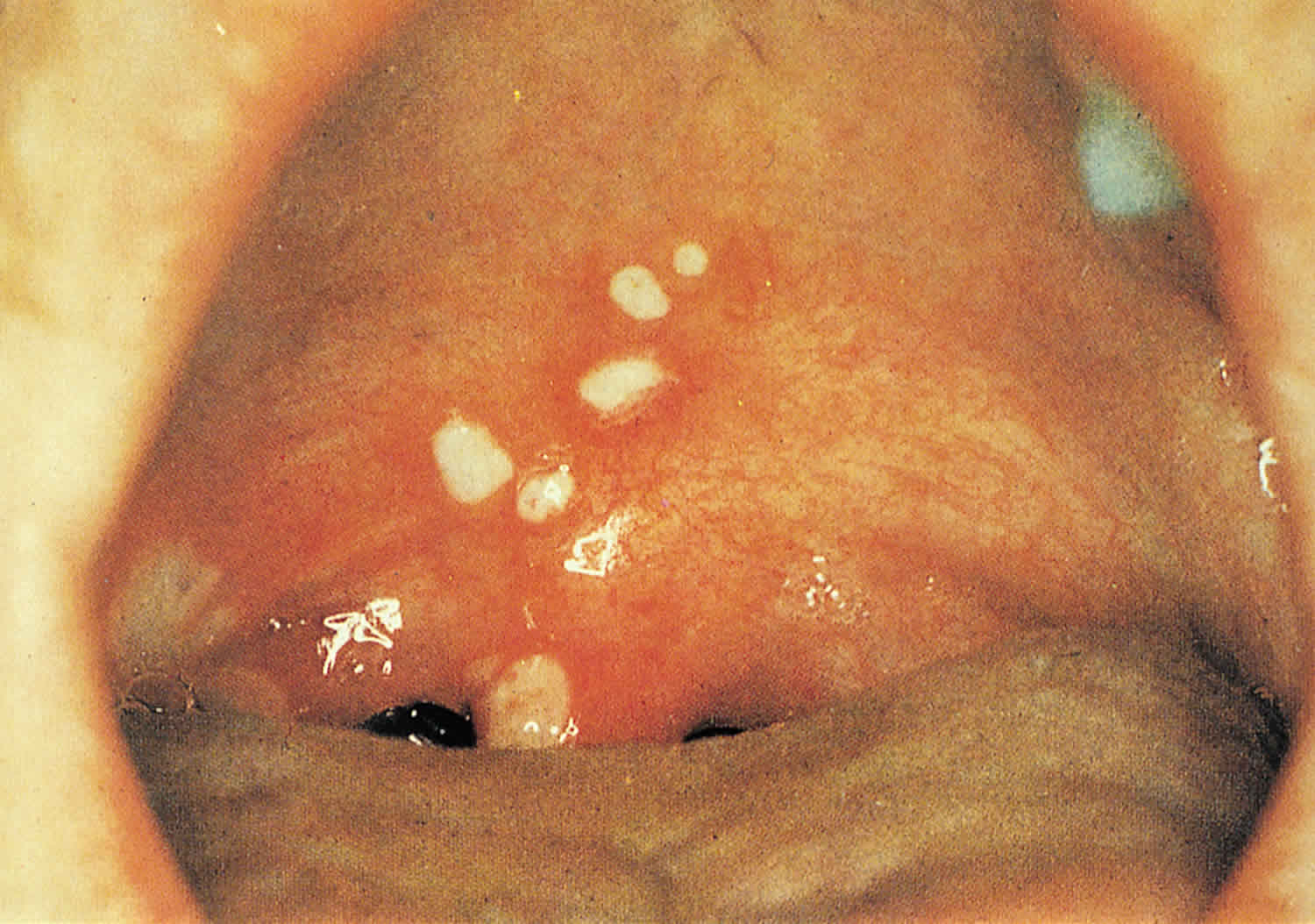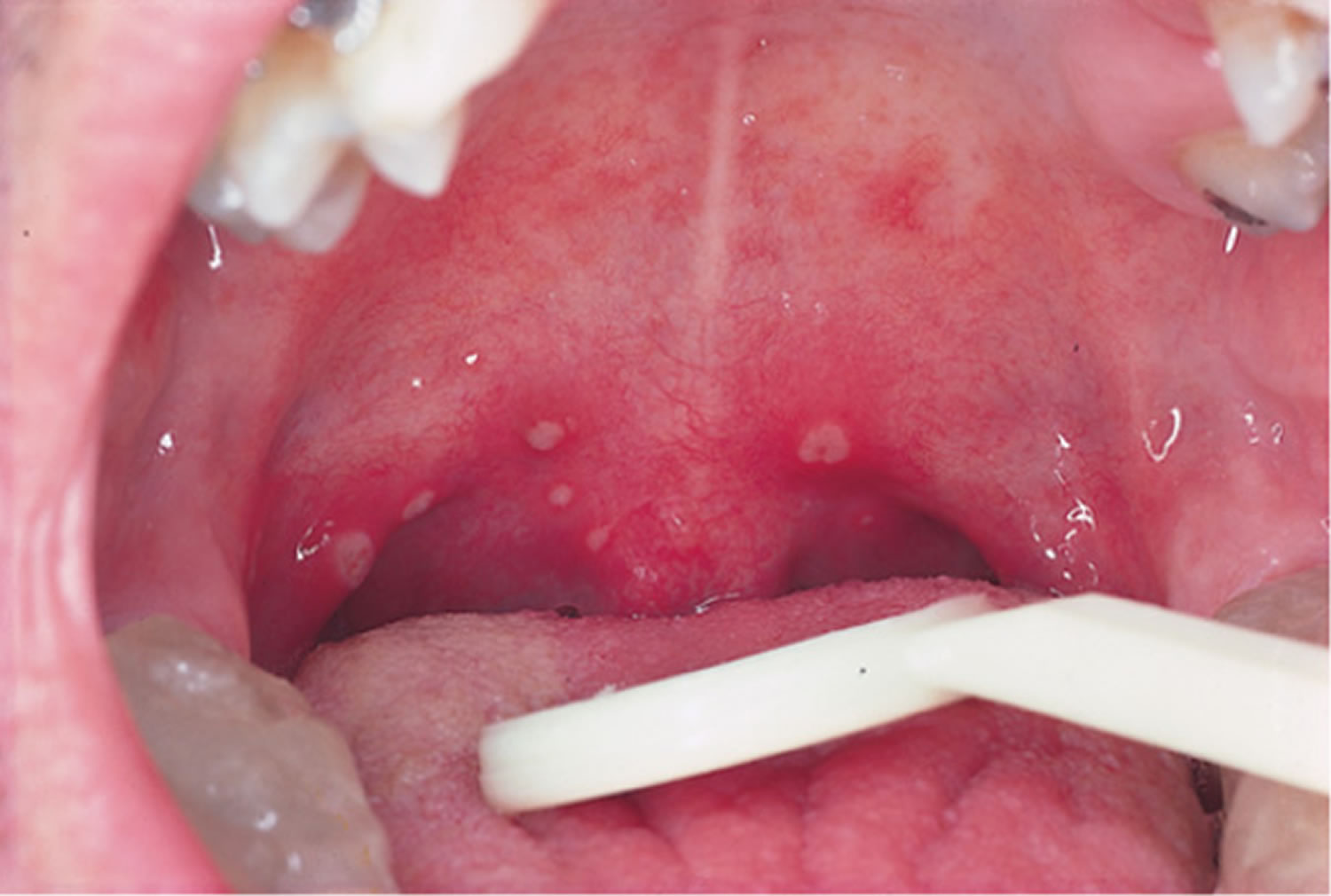What is herpangina
Herpangina is the name given to painful tonsils and soft palate (the fleshy back portion of the roof of the mouth) ulcers and red-ringed blisters due to a self-limited viral infection and usually occurs in childhood. Adolescents and adults are less frequently affected. Very young, elderly, immunocompromised, and pregnant patients can develop the more severe disease.
Herpangina is seen mainly in children up to 10 years of age, but may affect all ages from infants through to young adults. Herpangina is particularly common in children attending childcare facilities or schools. Older patients are most commonly infected via interfamilial spread or sporadic outbreaks in close communities such as military barracks. In some epidemics a slight male predominance has been reported. Infection rates peak in summer and early autumn in temperate climates. In tropical climates, herpangina usually occur during the rainy seasons. Epidemics tend to occur every 2-3 years when a new group of nonimmune young children become susceptible.
In most cases, herpangina coxsackievirus infections cause mild flu-like symptoms and go away without treatment. But in some cases, they can lead to more serious infections.
There is no specific therapy for herpangina and treatment is therefore symptomatic. Acetaminophen may be taken for fever and pain. Because of the fever and pain on swallowing, it is important to encourage sufficient fluid intake. Cold milk or water, ice cream and ice blocks are suitable. Hot drinks and fruit juices should be avoided because of the painful ulcers. Dehydration is probably the commonest complication of herpangina.
Most kids with a simple coxsackievirus infection recover completely after a few days without needing any medical treatment. A child who has a fever without any other symptoms should rest in bed or play quietly indoors. Offer plenty of fluids to prevent dehydration.
It is important to seek further medical advice if the illness does not improve in 1 week or if there is a deterioration or development of new symptoms.
Herpangina home remedy
Treatment is primarily supportive. The pain associated with these diseases is usually brief. Ibuprofen and acetaminophen are the mainstays of treatment, in conjunction with plenty of liquids to avoid dehydration.
The best way to prevent the spread of this disease among people is frequent hand washing, disinfecting of hard surfaces, and avoidance of shared drinks and food.
See your doctor immediately if your child has any of these symptoms:
- fever higher than 100.4°F (38°C) for infants younger than 6 months and higher than 102°F (38.8°C) for older kids
- poor appetite
- trouble feeding
- vomiting
- diarrhea
- difficulty breathing
- convulsions
- unusual sleepiness
- pain in the chest or abdomen
- sores on the skin or inside the mouth
- severe sore throat
- severe headache, especially with vomiting, confusion, or unusual sleepiness
- neck stiffness
- red, swollen, and watery eyes
- pain in one or both testicles
Figure 1. Herpangina
Is herpangina contagious?
Yes. Herpangina is usually caused by an enterovirus coxsackie A16 virus and is very contagious. Coxsackieviruses are very contagious. They can be passed from person to person on unwashed hands and surfaces contaminated by feces. Coxsackieviruses also can be spread through droplets of fluid sprayed into the air when someone sneezes or coughs.
Viral shedding can occur even in asymptomatic patients. Respiratory viral shedding can persist for up to 3 weeks and in the stool for up to 8 weeks. Patients are most contagious in the first 1 to 2 weeks of infection.
When an outbreak affects a community, risk for coxsackievirus infection is highest among infants and kids younger than 5. The virus spreads easily in group settings like schools, childcare centers, and summer camps. People are most contagious the first week they’re sick.
In cooler climates, outbreaks most often happen in the summer and fall, but tropical parts of the world have them year-round in.
How long does herpangina last?
How long the infection lasts can vary. In most kids, the fever lasts about 3 days, then disappears. The painful tonsils and soft palate ulcers take 5-10 days to heal, sometimes after the fever has settled.
Kids who only have a fever may see their temperature return to normal within 24 hours, although the average fever lasts 3 days.
What causes herpangina?
Herpangina is an enterovirus infection – these are viruses that infect the gastrointestinal tract. Herpangina is usually spread by the fecal-oral route and the virus may continue to be excreted in the feces long after the illness has recovered. Spread may also occur via respiratory and oral-oral routes or possibly via contaminated fomites (things such as towels, cups etc.) and fresh water. Transmission can additionally result from the ingestion of infected saliva, respiratory droplets, or direct contact with fluid from vesicles. The incubation period is approximately 4 days.
Herpangina is usually caused by coxsackie A16 virus and is highly contagious. Other common coxsackie A viruses isolated from herpangina are A1-10, 12 and 22. Less common causes are coxsackie B1-5, echoviruses, enterovirus 71, herpes simplex virus, parechovirus 1 and adenoviruses. Approximately 50% of enterovirus infections do not result in a clinical illness and these people are another source of infection without realizing it.
Enteroviruses are small, non-enveloped, single positive-strand RNA viruses. Enteroviruses are capable of surviving in a wide pH range and retain infectivity in temperatures up to 122 °F (50 °C) 1. These characteristics make them capable of surviving in the environment for relatively extended periods. Humans are the only natural host of these enteroviruses 1.
Long lasting immunity develops to the specific virus after recovery. However it is possible to have a second attack of herpangina due to an unrelated virus.
Herpangina prevention
There is no vaccine to prevent herpangina coxsackievirus infection. Hand washing is the best protection. Remind everyone in your family to wash their hands well and often, especially after using the toilet, after changing a diaper, before meals, and before preparing food. Shared toys in childcare centers should be cleaned often with a disinfectant because the virus can live on these objects for days.
Kids who are sick with a coxsackievirus infection should be kept out of school or childcare for a few days to avoid spreading the infection.
Herpangina symptoms
Coxsackievirus can produce a wide variety of symptoms. About half of all kids with an infection have no symptoms.
Others suddenly get a high fever, headache, and muscle aches, and some also develop a sore throat, abdominal discomfort, or nausea. A child with a coxsackievirus infection may simply feel hot but have no other symptoms. In most kids, the fever lasts about 3 days, then disappears.
Fever 101.3-104 °F (38.5-40 °C) is usually the first sign of infection with a general feeling of being unwell.
Sore throat and pain on swallowing develop. Red spots appear within hours (up to one day later) in the mouth and throat. The red spots become raised into small blisters (vesicles) which form a tiny yellowish ulcer with a red rim. These are the lesions called ‘herpangina’. The ulcers are generally 1-2mm (<5mm) in diameter. There are usually not many lesions (range 2-12). They are seen most commonly at the back of the mouth and throat such as on the soft palate, tonsils, uvula and back of throat. The mouth, throat and skin otherwise look normal. The ulcers take 5-10 days to heal, sometimes after the fever has settled.
Lymph glands in the neck can become enlarged and may be felt as firm smooth swellings on both sides of the neck.
Headache, backache, abdominal pain, vomiting and loss of appetite may be reported.
Herpangina is generally a mild self-limited infection, but rarely more serious neurological, heart and lung problems may complicate some enterovirus infections. Although enteroviruses are not believed to cross the placenta, some studies suggest maternal coxsackievirus infection may cause miscarriage or affect the developing baby.
Mothers can pass an infection to their newborns during or just after birth. Babies are more at risk for a serious infection, including myocarditis, hepatitis, and meningoencephalitis (an inflammation of the brain and meninges). In newborns, symptoms can develop within 2 weeks after birth.
How is herpangina diagnosed?
The diagnosis of herpangina is usually made clinically without the need for special tests. The typical symptoms with lesions at the back of the mouth and throat in a child in summer or autumn will make the diagnosis.
The virus can be isolated from nasopharyngeal swabs and also from urine, faeces and blood, as it is a systemic infection. Blood tests are usually within normal ranges. Biopsy of an ulcer does not show specific pathology. Serology will show a rising titre of specific antiviral IgM antibodies, first appearing after 1 week. The IgM antibodies persist for about 6 months and are replaced by specific IgG. However tests would not usually be required in an uncomplicated case of herpangina.
Herpangina can be distinguished from hand, foot and mouth disease, another enterovirus infection, by the lack of skin lesions. Primary herpes simplex virus infection of the mouth is usually more extensive including the gums, is very painful and lasts longer.
Herpangina treatment
There is no specific therapy for herpangina and treatment is therefore symptomatic. Acetaminophen or ibuprofen may be taken to relieve minor aches and pains. Because of the fever and pain on swallowing, it is important to encourage sufficient fluid intake. Cold milk or water, ice cream and ice blocks are suitable. Hot drinks and fruit juices should be avoided because of the painful ulcers. Dehydration is probably the commonest complication of herpangina.
Because antibiotics only work against bacteria, they can’t be used to fight a coxsackievirus infection.
If the fever lasts for more than 24 hours or if your child has any symptoms of a more serious coxsackievirus infection, see your child’s doctor.
It is important to seek further medical advice if the illness does not improve in 1 week or if there is a deterioration or development of new symptoms.
Herpangina is generally a mild self-limited infection, but rarely more serious neurological, heart and lung problems may complicate some enterovirus infections.
Occasionally, coxsackieviruses can cause more serious infections that may need to be treated in a hospital, including:
- viral meningitis, an infection of the meninges (membranes that surround the brain and spinal cord)
- encephalitis, a brain infection
- myocarditis, an infection of the heart muscle
Some small reports showed more rapid symptomatic improvement and decreased the duration of symptoms after treatment with acyclovir 1. Unfortunately, there has been no proven benefit reported in subsequent studies. Intravenous immunoglobulin (IVIG) has also been used to treat these diseases during major outbreaks in Asia, but no prospective data has been collected about the utility of this drug. For very severe cases the potential benefits of intravenous immunoglobulin outweigh any risks, and this drug may still be administered even without hard evidence regarding its efficacy. Patients with more serious presentations such as encephalitis or myocarditis should be admitted to the intensive care unit (ICU) for aggressive treatment and monitoring. Additionally, patients who are dehydrated or refuse to drink secondary to pain should be admitted for intravenous (IV) fluid therapy.
Herpangina prognosis
Herpangina are generally mild and self-limited. The more serious complications of these syndromes are caused almost exclusively by enterovirus A71. Acute complications include flaccid paralysis, meningitis/encephalitis, and myocarditis. More rarely these syndromes can cause fetal loss or conjunctival ulceration. Overall mortality rates for childhood myocarditis and encephalitis are both approximately 7%. Long-term complications include cardiomyopathy and persistent neurologic symptoms.
References





